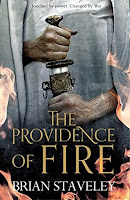Providence of Fire is the second in Brian Staveley’s
“Chronicles of the Unhewn Throne” series. It follows directly from the first,
which means it has a fair amount to live up to.
The world of Providence of Fire is hopefully familiar from
the first novel. A sprawling Empire, tied together by a shared culture across
uncommon geography, with an Imperial family that purports to carry a spark of
the divine. That they also tend to have glowing eyes to back this claim up is
rather helpful. In any event, at the close of the first book, the Emperor had
been murdered, and his three children were all trying to deal with this in
their own way. We do get to see a bit more of the Empire this time – actually,
we get to see a fair bit more of the capital city and the surrounding
countryside.
Staveley manages to make the Imperial city feel like a
baroque dream, filled with towering spires and open boulevards – and then
confounds expectations by taking us into the poorer quarters, the sewer runs,
the slums and garrets of the lower classes. The urban underclass here feel
appropriately misused, seething with vitality and distrust of authority. They’re contrasted with a military which is
shown as disciplined and effective, but ultimately supine in the hands of the
authority that they serve.
There’s a theme of strong personalities here – not
just the three Imperial children, whose efforts to gain control of their lives
and those around them are ministered by divine right, but generals, spiritual
figures, tribal leaders. These personalities shape the world around them, and
Staveley shows the driving power of those personalities, and their effect on
their followers, very effectively.
Speaking of powerful personalities – we also get a view of
some of the enemies of the Empire. In particular, we see an array of horsemen,
plains tribes, brought together by one strong leader. The horsemen of the
steppes are a staple of fantasy – Staveley’s happen to worship a divinity who
requires suffering. They see pain as sacrament, for both themselves and their
enemies. We don’t get to see enough of their social structures here – they
serve as a brooding external threat for most of the characters. Where they do
interact with one of our viewpoint characters, those interactions are either
verbally scathing or brutally violent. That said, those interactions are
executed perfectly – the focus of the tribes, their need for ‘hardening’, the
rather unpleasant games that they play – all are entirely believable in the
moment. It’s a shame though, that we don’t have time to delve deeper into the
tribes, as something apart from antagonists.
Character-wise, our key views are once again the three
children of the Emperor. We do spend
more time with the daughter in this novel, which is excellent. She served as an
excellent view on the politics of the Empire in the first book, but wasn’t
really given enough to do In this volume, there’s a rather larger share of
politics – and she takes up a rather larger share of the text. There’s some
interesting shifts in character as she gradually convinces those around her
that she may be divinely inspired – and we get to see the mental contortions
she goes through in trying to convince herself to take the Imperial throne,
unaware of whether either of her brothers are still alive.
One of her brothers is, to be fair, very much alive, and
leading a wing of Kettral – a sort of special forces team, which uses a giant
bird as both transport and tactical assault platform (the Kettral were always a
fun read in the first volume, and they maintain that streak here). The change
to our protagonist as he becomes used to the burdens – and costs – of command
is striking. The decisions he’s forced to make – whether to murder hostile
civilians to cover the team’s tracks, whether to assist members of the team or
focus on a high value target – leave both him and us morally wrung out. It’s a
fascinating rendition of the effects of high stress on an individual, somewhat
reminiscent of Heart of Darkness, and
Staveley keeps us mired in the mental morass alongside our viewpoint – evoking
sympathy, anger and horror in equal measure.
That leaves the heir to the throne, who has the capacity to
pass between various magical gates, after years of training in how to enter the
requisite mental state. From a character standpoint, he’s forged further here
as well. There’s issues around the cost of his actions, and whether it’s right
to sacrifice another person for your goals. Whether the world is ready for what
you’re trying to do, and whether, as always, the ends justify the means. It’s
all wrapped up in the plot here, rather than what felt like the more intimate
character study of the Kettral, but the character work slides in neatly
alongside the narrative, making a cohesive, wonderfully readable whole.
I won’t get into the plot, except to say that there’s…rather
a lot of it. There’s a great many pivot points in this book, where things can
fall out one way or another and have grand impact on what the first volume
described as the status quo. The pacing’s solid, the lead up and smaller crises
were more than enough to keep me reading – and then occasionally, there’d be an
absolute game changer, with ripples felt throughout the rest of the text.
Staveley isn’t playing around – this is high stakes politics, epic battles, and
real, lasting consequences felt in the narrative as a result.
Is it worth reading? Assuming you’ve read the first volume,
absolutely. It’s dialled everything up
to eleven, and you’ll be feeling the effects of Providence of Fire long after
you’re done reading it.

No comments:
Post a Comment